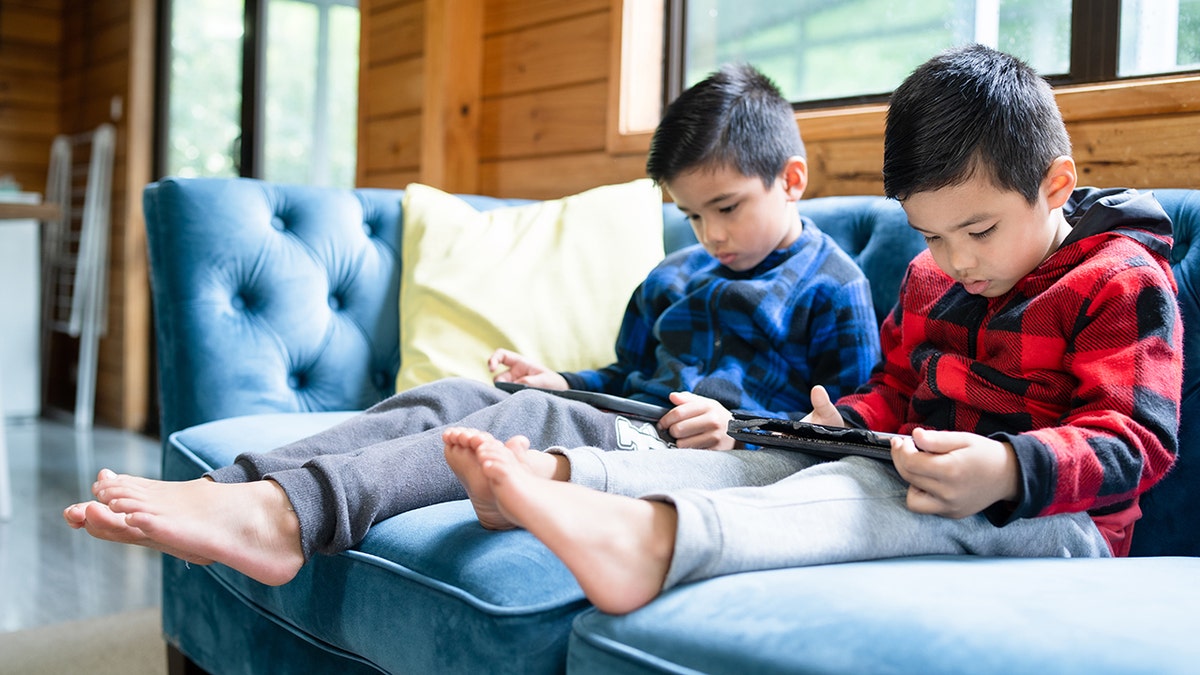Allowing very young children to access televisions and other screens could lead to sensory challenges for them later in childhood, according to a new study from Drexel University in Pennsylvania.
The study, “Early-Life Digital Media Experiences and Development of Atypical Sensory Processing,” was published on Jan. 8 in JAMA Pediatrics.
“This study finds an association between greater screen time in the first two years of life and ‘high’ sensory-related behaviors in areas,” the study’s lead author, Karen Heffler, M.D., an associate professor of psychiatry at Drexel University, told Fox News Digital.
BABIES, YOUNG CHILD EXPOSED TO MORE SCREEN TIME LINKED WITH DEVELOPMENTAL DELAYS: STUDY
To arrive at the findings, the research team analyzed data on TV or DVD-watching among 1,471 babies and toddlers at 12 months of age, 18 months and 24 months.
The data came from the National Children’s Study, a long-term look at “U.S. children and their parents designed to study environmental influences on child health and development,” according to the National Institute of Health.
The behavioral differences include “sensory seeking,” “sensory avoiding,” “sensory sensitivity” and “low registration,” Heffler said.
A child who is “sensory seeking” may be “attracted to spinning or shining objects” whereas a child with “low registration” would typically avoid eye contact and may not respond in a timely manner to being called or to familiar voices, said Heffler.
The study also found that children experienced different atypical behaviors depending on when they were exposed to screens.
“Although screen time of the children at each of the ages studied was found to be associated with atypical sensory processing at 33 months of age, the types of atypical sensory processing differed by the age of exposure,” Heffler noted.
LIMITING SCREEN TIME IN INFANTS MAY DECREASE RISK OF AUTISM SPECTRUM DISORDER, STUDY FINDS
Children exposed to any amount of screen time at the age of 12 months were found to have a 105% greater likelihood of exhibiting “high” sensory behaviors, according to a press release.
At 18 months old, each additional hour of daily screen time for children was associated with a 23% increased likelihood of “high” sensory behaviors as well as later sensation avoiding and low registration, the release stated.
“Atypical sensory processing is commonly seen in several behavioral health problems, including children with ADHD and up to 90% of children with autism.”
Screen exposure at 24 months “was associated with sensation avoidance, sensory sensitivity and sensation seeking,” said Heffler.
“Atypical sensory processing is commonly seen in several behavioral health problems, including children with ADHD and up to 90% of children with autism,” she also said.

Autism is typically not diagnosed until a child reaches 2 years of age, according to experts.
“Prior to this study, there was little understanding of potential risk factors for atypical sensory processing,” said Heffler.
While the American Academy of Pediatrics, based in Illinois, recommends that children avoid screen time altogether — aside from video chats with family members and friends — until they are about 18 to 24 months, “this study gives further evidence that screen time for the youngest children should be avoided,” the expert noted.
KIDS BENEFIT FROM ‘DITCHING THEIR DEVICES’ AT HOME: PARENTING EXPERT
Screen exposure among very young children had previously been linked to autism, ADHD, language delays and other brain differences, Heffler told Fox News Digital.
“This study adds atypical sensory processing to the list of other developmental outcomes,” she said.
As Heffler pointed out, infants “do not have the capability to fully understand what they see on TV or video, but the lights, colors, sounds and movement experienced during screen time would have an impact on how the neurons in the brain connect, potentially affecting sensory processing pathways and sensory-related behavior.”

The hope of researchers is that the study will aid clinicians who are encountering young patients with sensory issues, she said.
“For young children who are experiencing symptoms associated with atypical sensory processing, clinicians may wish to inquire about the children’s screen viewing habits,” Heffler said.
Parents and clinicians who are seeing these types of behaviors may want to try eliminating screen time in favor of “social interaction and play,” said the expert.
“There is emerging evidence that markedly reducing screen time and increasing socially engaging activities in young children with autism, for example, is associated with reduction of autism-related symptoms, including the sensory-related symptoms of restricted/repetitive behavior,” she added.
What’s a healthy amount of daily screen time for kids?
Per its website, the American Academy of Pediatrics discourages any use of media for children younger than age 2, as Fox News Digital previously reported.
For kids ages 2 years and older, the organization recommends capping screen time at two hours per day.

The American Academy of Child and Adolescent Psychiatry (AACAP) outlines specific guidelines for each age group on its website.
For babies up to 18 months, it recommends limiting screen use to video chatting with an adult.
Between 18 and 24 months, its guidelines are to use screens only for educational programming.
For kids between 2 and 5 years old, the AACAP recommends a limit of one hour per weekday and three hours on weekends for any non-educational screen time.
It does not specify an hourly limit for ages 6 and older but does recommend encouraging healthy habits and limiting screen-based activities.
“To be honest and point-blank, the least amount of screen time is healthy for children,” Dr. Zeyad Baker, a pediatric physician with Baker Health in New Jersey, previously told Fox News Digital.
CLICK HERE TO SIGN UP FOR OUR HEALTH NEWSLETTER
However, he noted that it gets trickier for parents to moderate when kids need to do homework online, and he said the quality of screen time comes into play when setting limits.
For more Health articles, visit www.foxnews.com/health.
Read the full article here